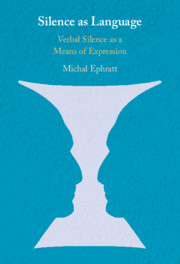2 - The Different Sorts of Silence
Published online by Cambridge University Press: 18 August 2022
Summary
Focusing on silence as means of expression, we first weed out other phenomena termed ‘silence’, some of which have nothing to do with language, while others form part of interaction but are not a means of expression. The primary measure serving this distinction is whether the referent so denoted is situated within interaction or external to it. Stillness, being external to interaction, includes numerous states external to the human body, such as the stillness of nature. The chapter includes an examination of silences referring to absence of speech and so falling in the realm of interaction in terms of their place and role within interaction, the matter of choice and the nature of the silence exposes diverse sorts of silences. Somatic and mental symptoms such as muteness are such that silence being its signifier is not the product of the speaker’s choice and does not serve interaction. Paralinguistic pauses constitute the temporal suspension of speech. Some such pauses serve interaction and some not. Moving to the content plane, the unsaid and empty speech are silences in terms of context, chosen by the speaker to conceal rather than communicate. Unlike the above, silencing is silence externally imposed on the potential speaker.
- Type
- Chapter
- Information
- Silence as LanguageVerbal Silence as a Means of Expression, pp. 5 - 29Publisher: Cambridge University PressPrint publication year: 2022



